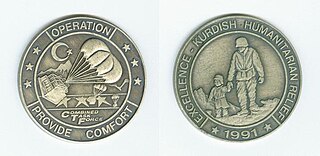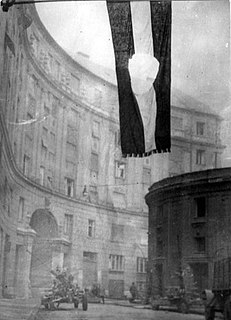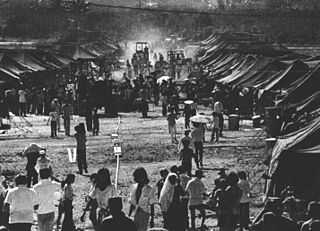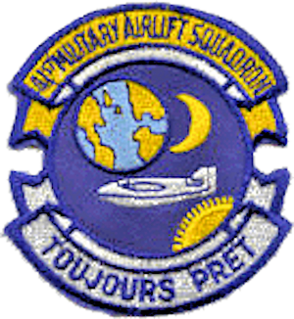Related Research Articles

USS Dwight D. Eisenhower (CVN-69) is a nuclear-powered aircraft carrier currently in service with the United States Navy. Commissioned in 1977, the ship is the second of the ten Nimitz-class aircraft carriers currently in service, and is the first ship named after the 34th President of the United States and General of the Army Dwight D. Eisenhower. The vessel was initially named simply as USS Eisenhower, much like the lead ship of the class, Nimitz, but the name was changed to its present form on 25 May 1970. The carrier, like all others of her class, was constructed at Newport News Shipbuilding Company in Virginia, with the same design as the lead ship, although the ship has been overhauled twice to bring her up to the standards of those constructed more recently.

Operation Provide Comfort and Provide Comfort II were military operations initiated by the United States and other Coalition nations of the Persian Gulf War, starting in April 1991, to defend Kurdish refugees fleeing their homes in northern Iraq in the aftermath of the Gulf War, and to deliver humanitarian aid to them. The no-fly zone instituted to help bring this about would become one of the main factors allowing the development of the autonomous Kurdistan Region.

The Hungarian Revolution of 1956, or the Hungarian Uprising, was a nationwide revolution against the Hungarian People's Republic and its Soviet-imposed policies, lasting from 23 October until 10 November 1956. Leaderless at the beginning, it was the first major threat to Soviet control since the Red Army drove Nazi Germany from its territory at the end of World War II in Europe.

Charles Erwin Wilson was an American engineer and businessman who served as United States Secretary of Defense from 1953 to 1957 under President Dwight D. Eisenhower. Known as "Engine Charlie", he was previously the president and chief executive officer of General Motors. In the wake of the Korean War, he cut the defense budget significantly.
Operation Deep Freeze is codename for a series of United States missions to Antarctica, beginning with "Operation Deep Freeze I" in 1955–56, followed by "Operation Deep Freeze II", "Operation Deep Freeze III", and so on.. Given the continuing and constant US presence in Antarctica since that date, "Operation Deep Freeze" has come to be used as a general term for US operations in that continent, and in particular for the regular missions to resupply US Antarctic bases, coordinated by the United States military.

The 109th Airlift Wing is a unit of the New York Air National Guard, stationed at Stratton Air National Guard Base, Schenectady, New York. If activated to federal service, the Wing is gained by the United States Air Force Air Mobility Command.

The Military Air Transport Service (MATS) is an inactive Department of Defense Unified Command. Activated on 1 June 1948, MATS was a consolidation of the United States Navy's Naval Air Transport Service (NATS) and the United States Air Force's Air Transport Command (ATC) into a single joint command. It was inactivated and discontinued on 8 January 1966, superseded by the Air Force's Military Airlift Command (MAC) as a separate strategic airlift command, and it returned shore-based Navy cargo aircraft to Navy control as operational support airlift (OSA) aircraft.

Carrier Airborne Early Warning Squadron 121 (VAW-121), also known as the "Bluetails", is an Airborne Early Warning (AEW) and Command and control (C2) squadron of the United States Navy, operating the E-2D Hawkeye. Established in 1967, the squadron is based at NAS Norfolk. It is currently assigned to Carrier Air Wing 7 and deploys aboard the aircraft carrier USS Abraham Lincoln.

The 374th Airlift Wing is a unit of the United States Air Force assigned to Fifth Air Force. It is stationed at Yokota Air Base, Japan. It is part of Pacific Air Forces. The 374th Airlift Wing is the only airlift wing in PACAF and provides airlift support to all Department of Defense agencies in the Pacific theater of operation. It also provides transport for people and equipment throughout the Kantō Plain and the Tokyo metropolitan area.

Donaldson Air Force Base is a former facility of the United States Air Force located south of Greenville, South Carolina. It was founded in 1942 as Greenville Army Air Base; it was deactivated in 1963 and converted into a civilian airport. It is currently an active airfield known as Donaldson Center Airport.

The 60th Air Mobility Wing is the largest air mobility organization in the United States Air Force and is responsible for strategic airlift and aerial refueling missions around the world. It is the host unit at Travis Air Force Base in California. Wing activity is primarily focused on support in the Middle East region, however it also maintains operations in areas of the Pacific and Indian Oceans.
"Peace in the Valley" is a 1939 song written by Thomas A. Dorsey, originally for Mahalia Jackson. Its full title is "There'll Be Peace In The Valley For Me". The song was a hit in 1951 for Red Foley and the Sunshine Boys, reaching number seven on the Country & Western Best Seller chart. It was among the first gospel recordings to sell one million copies. Foley's version was a 2006 entry into the Library of Congress' National Recording Registry.

Operation New Life was the care and processing on Guam of Vietnamese refugees evacuated before and after the Fall of Saigon, the closing day of the Vietnam War. More than 111,000 of the evacuated 130,000 Vietnamese refugees were transported to Guam where they were housed in tent cities for a few weeks while being processed for resettlement. The great majority of the refugees were resettled in the United States. A few thousand were resettled in other countries or chose to return to Vietnam on the vessel Thuong Tin.

The 22nd Airlift Squadron, sometimes written as 22d Airlift Squadron, is part of the 60th Air Mobility Wing at Travis Air Force Base, California. It operates C-5M Galaxy aircraft supporting the United States Air Force global reach mission worldwide. The mission is to provide services and support which promote quality of life and project global power through combat-proven airlift and airdrop.

Operation Sea Signal was a United States Department of Defense operation in the Caribbean in response to an influx of Cuban and Haitian migrants attempting to gain asylum in the United States. As a result, the migrants became refugees at Guantanamo Bay Naval Base. The operation took place from August 1994 to February 1996 under Joint Task Force 160. The task force processed over 50,000 refugees as part of the operation. The U.S. Coast Guard and U.S. Navy rescued refugees from the sea and other migrants attempted to cross the landmine field that then separated the U.S. and Cuban military areas. Soldiers, Airmen, and Marines provided refugee camp security at Guantanamo Bay, and ship security on board the Coast Guard cutters. This mass exodus led to the U.S. immigration implementation of the Wet Feet Dry Feet Policy. The mass Cuban exodus of 1994 was similar to the Mariel boat lift in 1980.

The Bell 47J Ranger is an American single-engine single-rotor light helicopter manufactured by Bell Helicopter. It was an executive variant of the highly successful Bell 47 and was the first helicopter to carry a United States president.
The US President's Committee for Hungarian Refugee Relief was established by President Dwight D. Eisenhower on December 12, 1956. Tracy S. Voorhees served as Chairman. The need for such a committee came about as a result of the United States' desire to provide for a share of the Hungarians who fled their country beginning in October 1956. The Committee operated until May 1957. During this time, the Committee helped re-settle in the United States over 30,000 Hungarian refugees. The Committee's small staff was funded from the Special Projects Group appropriation. A portion of the committee's records are preserved in Voorhees' papers in Special Collections and University Archives at Rutgers University and are accessible online.

The 41st Military Airlift Squadron is an inactive United States Air Force unit. It was last assigned to the 437th Military Airlift Wing, Military Airlift Command, stationed at Charleston Air Force Base, South Carolina.

The 18th Airlift Squadron is an inactive United States Air Force unit. Its last assignment was to the 305th Operations Group, Air Mobility Command, stationed at McGuire Air Force Base, New Jersey.

The 63d Air Expeditionary Wing is a provisional unit of the United States Air Force. It is assigned to Air Mobility Command to activate or inactivate as needed. No publicly available information indicates it has been active as an expeditionary unit. The wing was last active as the 63d Airlift Wing at Norton Air Force Base, California, where it was inactivated on 1 April 1994.
References
- 1 2 3 Markowitz, Arthur A. (Spring 1973). "Humanitarianism versus Restrictionism: The United States and the Hungarian Refugees". The International Migration Review. 7:1: 46–59 (48, 49, 58) – via JSTOR.
- ↑ Haulman, Daniel L. (1998). The United States Air Force and Humanitarian Airlift Operations 1947-1994. Defense Technical Information Center. p. 245. OCLC 1011761145.